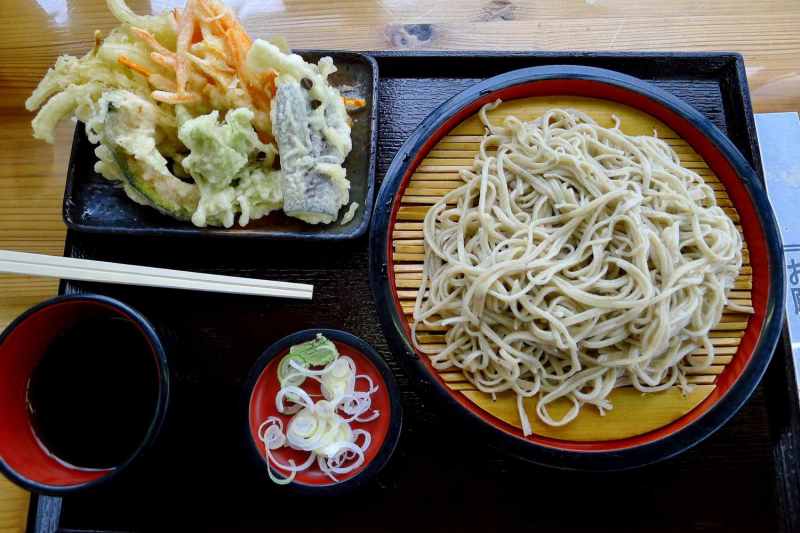Prep: 10 mins
Cook: 30 mins
Total: 40 mins
Serving: 1 serving
Tenzaru soba is a classic Japanese summer dish that is equally as popular as zaru soba or udon and readily available on restaurant menus. It is a dish that combines two classic Japanese favorites: tempura seafood and vegetables, and zaru style cold noodles served on a bamboo dish.
As far as presentation is concerned, the tempura is always served separately from the cold soba noodles on different plates. A savory soy sauce based dipping sauce is served in a cup large enough to dip both noodles and tempura, along with a small plate of sliced green onions, wasabi (Japanese horseradish), and grated daikon (Japanese daikon radish).
When prepared as a stand-alone appetizer or meal, tempura is served with either salt or a side of tempura sauce. However, when tempura is served in a dish of tenzaru soba, the tempura is dipped in mentsuyu, or a dipping sauce (tsuyu) meant for noodles (men), and not in tempura sauce. Side by side, tempura sauce and the dipping sauce for noodles appear almost identical, as both are brown in color and thin liquids. Their flavor profiles, however, are different to the discriminating palate.
To prepare tenzaru at home, there are a few tips and shortcuts I recommend, especially if you’re interested in preparing a wonderful Japanese dish with ease, or if you are limited on time. We encourage you to spend as little or as much time as you desire in preparing this dish.
Ingredients
-
1/2 cup mentsuyu, for a soba dipping sauce, amount as needed
-
Green onions, sliced, for garnish
-
Daikon, Japanese radish, grated, for garnish
-
Wasabi, Japanese horseradish, for garnish
-
5 to 6 pieces tempura vegetables, per person
-
2 to 3 pieces tempura shrimp, per person
-
8 ounces soba buckwheat noodles, per person
Steps to Make It
-
Gather the ingredients.
-
Prepare the mentsuyu (soba dipping sauce). Place in a cup and chill in the refrigerator.
-
Slice green onions and grate daikon (Japanese radish). Plate small individual size portions of each, along with wasabi and store in the refrigerator until ready to serve.
-
Cook soba noodles according to frozen or dried noodle package directions. Drain, rinse with cold water and quickly chill the noodles by placing some ice cubes directly in the colander.
-
Make tempura batter and fry tempura if you are not using pre-made tempura. For tempura vegetables, almost any type of vegetable may be used: kabocha pumpkin, asparagus, sweet potato, broccoli, zucchini, bell pepper, eggplant, green beans, renkon (lotus root), shiso (perilla leaf), seaweed.
-
Plate soba noodles on bamboo zaru tray (which helps to drain any excess water), on a separate dish plate tempura, and serve with dipping sauce and garnishes (scallions, grated daikon, and wasabi.)
Tips
- Frozen fresh soba noodles are easy to store in the freezer and can be prepared in boiling water in 1 to 2 minutes. The noodles have great texture and require less time to prepare than dried soba noodles.
- For the soba dipping sauce, it is convenient to purchase pre-made, bottled soba sauce. “Mentsuyu” is a brand of concentrated noodle sauce that can be used for all different types of noodle dishes. You’ll find there are many different brands of soba sauce available at Japanese and Asian grocery stores in the West, as well as online.
- Tempura batter mix is available as a dry ingredient and pre-packaged at most Japanese supermarkets. All that is needed to the mix is usually water, egg, or both.
- Tempura shrimp, battered, partially cooked, and frozen is available in the freezer section of select Japanese grocery stores.
- Tempura seafood and vegetable combination dishes are available pre-made in the deli section of select Japanese grocery stores. Tempura can be reheated to its original crispy texture by reheating it in a dry pan over the stove.
| Nutrition Facts | |
|---|---|
| Servings: 1 | |
| Amount per serving | |
| Calories | 756 |
| % Daily Value* | |
| Total Fat 36g | 46% |
| Saturated Fat 4g | 18% |
| Cholesterol 135mg | 45% |
| Sodium 2354mg | 102% |
| Total Carbohydrate 87g | 32% |
| Dietary Fiber 13g | 48% |
| Total Sugars 16g | |
| Protein 28g | |
| Vitamin C 96mg | 481% |
| Calcium 210mg | 16% |
| Iron 5mg | 27% |
| Potassium 1851mg | 39% |
| *The % Daily Value (DV) tells you how much a nutrient in a food serving contributes to a daily diet. 2,000 calories a day is used for general nutrition advice. | |

